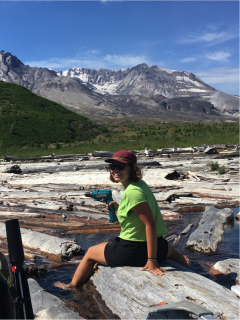by Emma Sevier and Kena Fox-Dobbs, Geology Department, University of Puget Sound

At first glance, Spirit Lake may look like many other lakes in the Cascades, clear blue water perched in a rugged alpine basin. However, this lake, within the blast zone of the 1980 Mount St. Helens eruption, has a more complex story to tell. The eruption of Mount St. Helens released a landslide of hot volcanic debris that sterilized Spirit Lake and restructured the lake basin. Today Spirit Lake is considerably shallower and has a greater surface area than the pre-eruption lake.
The current view of Spirit Lake includes a unique and obvious feature; the floating logs that cover ~20% of the lake surface. This log mat was derived from trees that were blown down during the eruption — a reminder of the mature forest that once surrounded the lake. While these sun-bleached and weathered logs are essentially skeletons of past life, our research has revealed that they still play an important role in the lake ecosystem. The logs themselves are no longer a source of energy or nutrients, but they provide a novel substrate for biofilm (aka periphyton), a form of primary productivity consisting of cyanobacteria, diatoms, and algae. This green slime may not look like much, but we have documented the potential contribution of biofilm to the base of the lake food web, including the input of nutrients via atmospheric N2 fixation.
Studying floating logs is surprisingly challenging; much like at a rodeo, the logs must first be lassoed, corralled, and then ridden… by the end of the field season our research team has strong arms and nimble feet! This interdisciplinary team included ourselves (biogeochemists) an environmental chemist (Jim Gawel, UW-Tacoma), an entomologist (Jeremy Davis, UW-Tacoma), and a limnologist (Avery Shinneman, UW-Bothell). Instead of chasing logs around all summer (and potentially losing deployed instruments), we constructed experimental log mats (100 meters2) that were anchored in place, and we used these to study the log mat micro-ecosystem. Other aspects of our field research included monitoring water chemistry, sampling shallow sediments and collecting sediment cores.
One of the first questions we wanted to answer was how much log mat biofilm was in Spirit Lake. We combined field, laboratory and satellite imagery approaches to estimate the standing biomass of log mat biofilm in late summer. We determined there was roughly 12,500 kilograms of biofilm (equivalent to the weight of 1.5 Tyrannosaurus rex adults) fixed to the floating log mat by the end of growing season. In other words, a lot of biofilm primary productivity was available to the lake food web!
Once we had established that biofilm was a substantial component in the lake system, we addressed the issue of atmospheric nitrogen fixation by cyanobacteria in the biofilm. To do this, we collected biofilm samples from glass slide racks suspended under the experimental log mats for stable isotope analysis. Because atmospheric N2 has a nitrogen isotope value that is distinct from nitrate in the lake water, we were able use the isotopic values of biofilm to determine the relative contributions of each nitrogen source to the biofilm. We found evidence of N2 fixation, which indicates that log mat biofilm is an input of both organic carbon and nitrogen into the lake system. It is likely that there is a seasonal trend in the strength of this input, since preliminary assemblage analyses of the biofilm community suggest that cyanobacteria increase in abundance later in the summer, potentially once lake nitrate levels have been drawn down to low concentrations by other primary producers earlier in the growth season.
As with most research projects, this one has sparked more questions than answers, and recently we’ve turned our attention to the lake sediments, which act as integrators and recorders of lake biogeochemical processes. Specifically, we are now working to determine how the sediment organic record has changed through time, and across space in areas of the lake with different patterns of log mat occupancy. Over the past 38 years, the Spirit Lake ecosystem has rapidly evolved from sterile to functional, perhaps with a bit of help from the log mat biofilm!










